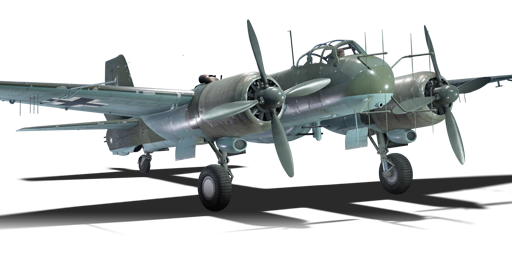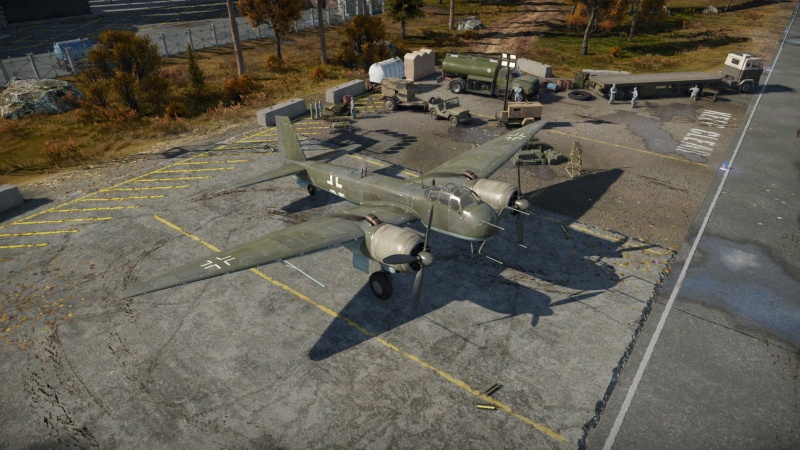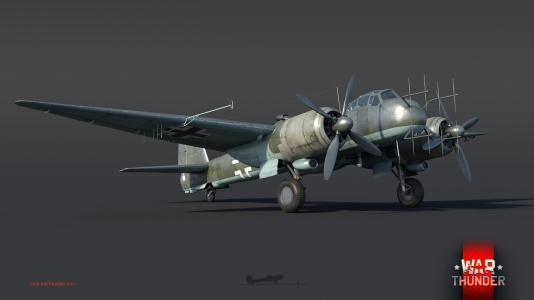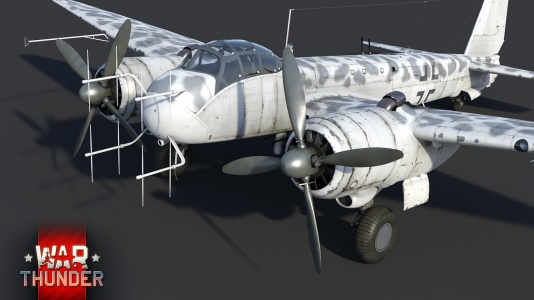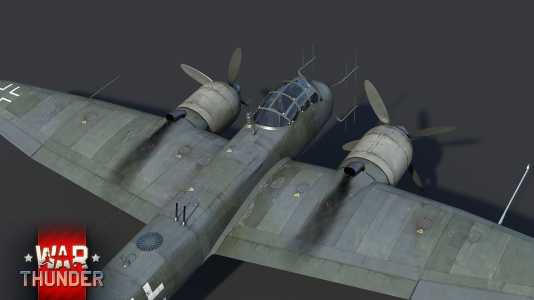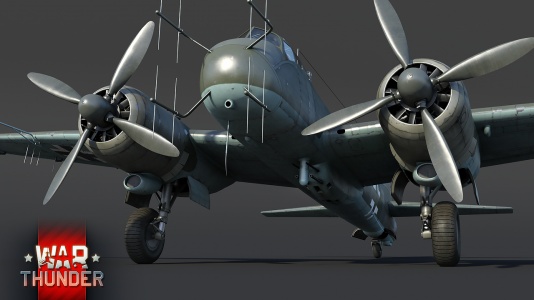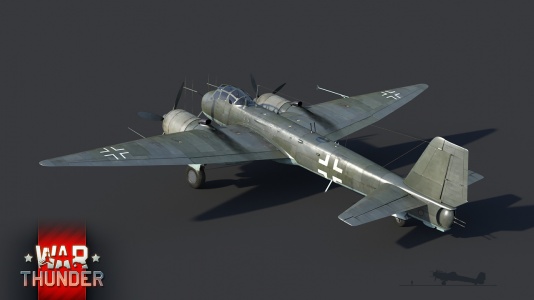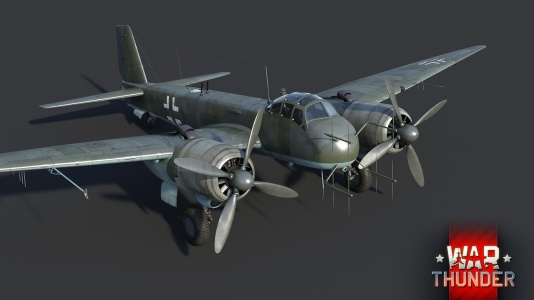Difference between revisions of "Ju 388 J"
(Edits) |
(→Defensive armament) |
||
| Line 95: | Line 95: | ||
The '''''{{PAGENAME}}''''' is defended by: | The '''''{{PAGENAME}}''''' is defended by: | ||
| − | * 2 x 13 mm MG 131 machine guns, turret (600 rpg = 1,200 total) | + | * 2 x 13 mm MG 131 machine guns, tail turret (600 rpg = 1,200 total) |
== Usage in battles == | == Usage in battles == | ||
Revision as of 20:19, 13 July 2022
Contents
Description
The Ju 388 J is a premium gift rank IV German twin-engine fighter with a battle rating of 4.7 (AB) and 4.3 (RB/SB). It was introduced in Update 1.87 "Locked On" during the "Battlefield Engineer" event. It is the final development of the Ju 88 family of aircraft. It is currently a rare vehicle and is only obtainable through the Marketplace.
General info
Flight performance
| Characteristics | Max Speed (km/h at 10,600 m) |
Max altitude (metres) |
Turn time (seconds) |
Rate of climb (metres/second) |
Take-off run (metres) | |||
|---|---|---|---|---|---|---|---|---|
| AB | RB | AB | RB | AB | RB | |||
| Stock | 598 | 581 | 13000 | 30.4 | 31.6 | 6.6 | 6.5 | 1,000 |
| Upgraded | 645 | 621 | 27.7 | 29.0 | 11.7 | 8.9 | ||
Details
| Features | ||||
|---|---|---|---|---|
| Combat flaps | Take-off flaps | Landing flaps | Air brakes | Arrestor gear |
| ✓ | ✓ | ✓ | X | X |
| Limits | ||||||
|---|---|---|---|---|---|---|
| Wings (km/h) | Gear (km/h) | Flaps (km/h) | Max Static G | |||
| Combat | Take-off | Landing | + | - | ||
| 675 | 310 | 457 | 428 | 280 | ~11 | ~7 |
| Optimal velocities (km/h) | |||
|---|---|---|---|
| Ailerons | Rudder | Elevators | Radiator |
| < 370 | < 360 | < 400 | > 280 |
Survivability and armour
Examine the survivability of the aircraft. Note how vulnerable the structure is and how secure the pilot is, whether the fuel tanks are armoured, etc. Describe the armour, if there is any, and also mention the vulnerability of other critical aircraft systems.
Modifications and economy
Armaments
Offensive armament
The Ju 388 J is armed with:
- 2 x 30 mm MK 108 cannons, chin-mounted (110 rpg = 220 total)
- 2 x 20 mm MG 151 cannons, chin-mounted (180 rpg = 360 total)
- 2 x 20 mm MG 151 cannons, Schräge Musik mounted mid-fuselage (200 rpg = 400 total)
Defensive armament
The Ju 388 J is defended by:
- 2 x 13 mm MG 131 machine guns, tail turret (600 rpg = 1,200 total)
Usage in battles
Describe the tactics of playing in the aircraft, the features of using aircraft in a team and advice on tactics. Refrain from creating a "guide" - do not impose a single point of view, but instead, give the reader food for thought. Examine the most dangerous enemies and give recommendations on fighting them. If necessary, note the specifics of the game in different modes (AB, RB, SB).
Radars
The Ju 388 J is equipped with a FuG-202 search radar, located in the nose of the aircraft; a control box which is part of the radar damage model is located in the rear of the cockpit.
| FuG-202 - Target Detection Radar | |||
|---|---|---|---|
| Maximum Detection Range |
Guaranteed Detection Range |
Max Azimuth Scan Angle |
Max Elevation Scan Angle |
| 4,000 m | 4,000 m | ±30° | ±30° |
Manual Engine Control
| MEC elements | ||||||
|---|---|---|---|---|---|---|
| Mixer | Pitch | Radiator | Supercharger | Turbocharger | ||
| Oil | Water | Type | ||||
| Not controllable | Controllable Auto control available |
Controllable Auto control available |
Controllable Not auto controlled |
Separate | Not controllable 1 gear |
Not controllable |
Pros and cons
Pros:
- Good offensive armament of 2 x 30 mm MK 108 and 2 x 20 mm MG 151 cannons
- Access to the powerful Minengeschoß rounds
- Benefits from an airspawn in RB
- Excellent bomber hunter
- Schräge Musik 20 mm cannons with dedicated gunsight
Cons:
- Subpar roll rate, speed and overall performance
- Hard to get guns on target
- Bad climb rate
- Can't sustain any turnfight
History
The Ju 388 J is the heavy-fighter version of the Ju 388, a multirole twin-engined combat aircraft built by Germany late into the Second World War. Based on the Ju 188 and Ju 88, the aircraft was optimized for high-altitude operations to counter the formidable B-29 Superfortress; the aircraft incorporated specific design features for this role including a pressurized cockpit. However, the aircraft was plagued by technical issues and entered service late into the war, meaning that it saw little service.
In late 1942, the German Air Ministry (or RLM) first learned of the American B-29 Superfortress, which would've been capable of cruising such a high altitude (8000-10000 metres) that no German aircraft could counter it effectively. As a result, the RLM authorized the development of several new aircraft to counter the Superfortress, including the Ta 152 H. For the bomber destroyer role, several aircraft were considered including the Do 335, Ta 152 and He 219: the He 219 and Ta 152 weren't optimized for high-altitude flight and were subsequently not considered, while the Do 335 was still in a prototype stage with production models not expected until 1944.
As a result, the RLM authorized the development of the Ju 388, based on the airframe of the Ju 188 fast-bomber, which was in turn based on the Ju 88. Compared to the Ju 188, the Ju 388 featured numerous changes, including the removal of most defensive armament; instead, a pair of 13 mm machine guns were mounted in the tail, remotely controlled from the crew cabin. The Ju 388 K and L (the bomber and reconnaissance versions) retained the glazed nose of the Ju 188, while the Ju 388 J featured a solid nose housing two 20 mm MG 151/20 and two 30 mm MK 108 cannons.
The Ju 388 first entered service in 1944; roughly 100 Ju 388 aircraft of all models were built in total (the exact number is not known). However, only three Ju 388 J aircraft were completed. The aircraft were used against allied bombers in WW2, and were also proposed for export to Japan. Following the end of the war, a single Ju 388 L was acquired by the USAF for testing purposes - this aircraft is now stored at the Smithsonian National Air and Space Museum in Washington DC, and is the only Ju 388 still intact today.
Devblog
After the German Ministry of Aviation (RLM) found out about the new American B-29 Superfortress in 1942, serious concerns were raised among high ranking officials, questioning the Luftwaffe's ability to deal with such a new potential threat. At the time, the B-29 flew higher and faster than any fighter the Luftwaffe had at their disposal and the only weapon that could effectively counter it was the 12.8cm FlaK 40 heavy AA cannon. This led to the development of a range of new German high-altitude fighters, interceptors and dedicated bomber hunters.
The first prototype of the Ju 388 performed its maiden flight in December 1943, showing promising results. After the construction and testing of six further prototypes were completed in three modifications: the Ju 388J high-altitude interceptor, a Ju 388K medium bomber and the Ju 388L scout. The Ju 388 was ordered into production and was officially introduced into Luftwaffe service in summer 1944. However, initial production progressed at a slow pace due to the limited availability of the required engines for the aircraft. Furthermore, the continuously worsening war conditions in Germany had a severe impact on overall production, eventually preventing it entirely by the end of the war.
In the end, only around 100 Ju 388s were built with most aircraft seeing only limited action during their short service life during the final stages of WW2.
Media
- Skins
- Images
- Videos
See also
Links to the articles on the War Thunder Wiki that you think will be useful for the reader, for example:
- reference to the series of the aircraft;
- links to approximate analogues of other nations and research trees.
External links
- [Development] Junkers Ju 388 J: The High-Altitude Marauder
- Official data sheet - more details about the performance
| Junkers Aircraft and Motor Works (Junkers Flugzeug- und Motorenwerke Aktiengesellschaft) | |
|---|---|
| Fighters | Ju 88 C-6 · Ju 388 J |
| Strike Aircraft | |
| Ju 87 | Ju 87 G-1 · Ju 87 G-2 |
| Bombers | Ju 88 A-1 · Ju 88 A-4 · Ju 188 A-2 · Ju 288 C |
| Ju 87 | Ju 87 B-2 · Ju 87 D-3 · Ju 87 D-5 · Ju 87 R-2 · Ju 87 R-2 Libya |
| Export | ▄Ju 87 D-3 · ▄Ju 87 R-2 · ▄Ju 88 A-4 |
| Germany twin-engine fighters | |
|---|---|
| Messerschmitt | Bf 109 Z-1 |
| Me 410 A-1/U2 · Me 410 B-1/U2 | |
| Dornier | Do 17 Z-7 · Do 217 J-1 · Do 217 J-2 · Do 217 N-1 · Do 217 N-2 |
| Focke-Wulf | Ta 154 A-1 |
| Junkers | Ju 88 C-6 · Ju 388 J |
| Germany premium aircraft | |
|---|---|
| Fighters | He 51 B-2/H · BV 155 B-1 |
| He 112 | He 112 B-1/U2 · He 112 B-2/U2 |
| Bf 109 | Flegel's Bf 109 A · Bf 109 E-7/U2 · Bf 109 G-2 |
| Fw 190 | Fw 190 A-5/U14 · Fw 190 C · Fw 190 D-13 |
| Captured | ▀Marcolin's C.R.42 CN · ▀Hawk H-75A-2 · ▀Yak-1B · ▀La-5FN · ▀P-47D-16-RE · ▀P-47D · ▀Tempest Mk V |
| Twin-engine fighters | Bf 109 Z-1 · Ju 388 J · Ta 154 A-1 |
| Jet fighters | ◄Sea Hawk Mk.100 · ◄G.91 R/4 · FFA P-16 · ◄MiG-21 SPS-K · ◊MiG-21 "Lazur-M" |
| Strike aircraft | Hs 129 B-2 (Romania) · ▀IL-2 (1942) · Bf 110 C-6 · Do 335 B-2 · He 219 A-7 · ◄Tornado IDS WTD61 · ◄Su-22M4 WTD61 |
| Bombers | Ar 196 A-3 · BV 238 · Fw 189 A-1 · He 177 A-3 · Ju 87 R-2 Libya · Ju 288 C · ▀Wellington Mk Ic |


